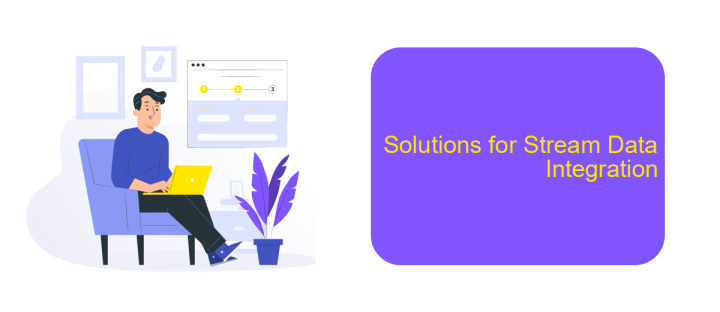Stream Data Integration
Stream Data Integration is a crucial process in modern data management, enabling real-time data flow across diverse systems and applications. By seamlessly integrating streaming data, organizations can enhance decision-making, improve operational efficiency, and gain valuable insights. This article explores the key concepts, benefits, and technologies behind stream data integration, highlighting its significance in today's fast-paced digital landscape.
Introduction
Stream Data Integration (SDI) is a crucial component for modern businesses that need to process and analyze real-time data from various sources. By enabling seamless data flow, SDI helps organizations make timely and informed decisions, improving operational efficiency and competitive advantage.
- Real-time data processing
- Seamless integration of multiple data sources
- Enhanced decision-making capabilities
One of the key tools for achieving efficient stream data integration is ApiX-Drive. This service allows businesses to automate data workflows and integrate various applications without the need for coding. With ApiX-Drive, companies can easily connect different data sources, ensuring that data is always up-to-date and accessible for analysis. By leveraging such tools, organizations can streamline their data integration processes and focus on deriving actionable insights from their data.
Benefits of Stream Data Integration

Stream data integration offers numerous advantages, significantly enhancing real-time data processing and decision-making capabilities. By enabling continuous data flow between systems, organizations can achieve more accurate and timely insights. This real-time data processing allows businesses to respond to market changes promptly, optimize operations, and improve customer experiences. Additionally, stream data integration reduces latency, ensuring that data is always up-to-date and relevant for analytics and reporting purposes.
Another significant benefit is the simplification of data management. Services like ApiX-Drive facilitate seamless integration by automating data synchronization between various platforms and applications. This reduces the need for manual intervention and minimizes the risk of errors. Furthermore, ApiX-Drive's user-friendly interface allows for easy setup and customization of integrations, making it accessible even for non-technical users. As a result, businesses can focus on leveraging their data for strategic initiatives rather than getting bogged down by complex integration processes.
Challenges of Stream Data Integration

Stream data integration presents several challenges that organizations must address to ensure seamless and efficient data flow. These challenges include data consistency, latency, scalability, and security, each of which can significantly impact the effectiveness of data integration strategies.
- Data Consistency: Ensuring that data remains consistent across different systems and data streams is a complex task. Inconsistencies can lead to inaccurate analytics and poor decision-making.
- Latency: Minimizing the time delay in data transmission is crucial for real-time analytics and decision-making. High latency can render data less useful or even obsolete.
- Scalability: As data volumes grow, the integration system must be able to scale efficiently. Handling large data streams without performance degradation is a significant challenge.
- Security: Protecting data in transit and ensuring compliance with data privacy regulations is vital. Security breaches can lead to data loss and legal repercussions.
To address these challenges, organizations can leverage services like ApiX-Drive, which offers robust tools for configuring and automating data integrations. ApiX-Drive simplifies the process of connecting various data sources, ensuring data consistency, reducing latency, and providing scalable solutions while maintaining high security standards.
Solutions for Stream Data Integration

Stream data integration is a crucial aspect of modern data architecture, enabling real-time data processing and analytics. Efficient integration solutions ensure that data flows seamlessly between disparate systems, enhancing operational efficiency and decision-making capabilities.
One of the key challenges in stream data integration is managing the continuous influx of data from various sources. To address this, businesses can leverage specialized tools and platforms that facilitate seamless data integration and transformation. These solutions not only streamline data workflows but also ensure data integrity and consistency.
- Scalability: Solutions must handle large volumes of data without compromising performance.
- Flexibility: Integration tools should support various data formats and sources.
- Real-time Processing: Ensures immediate data availability for analytics and decision-making.
- Data Security: Protects sensitive information during the integration process.
ApiX-Drive is an example of a service that simplifies stream data integration by offering a user-friendly interface for connecting multiple applications and automating data workflows. It supports a wide range of data sources and formats, ensuring that businesses can integrate their data streams efficiently and securely.
Conclusion
Stream Data Integration has emerged as a crucial technology in managing and processing real-time data efficiently. By enabling seamless integration and synchronization of data from various sources, it ensures that businesses can make timely and informed decisions. The ability to handle high-velocity data streams allows organizations to stay competitive and responsive to market changes, ultimately driving innovation and growth.
Tools like ApiX-Drive play a significant role in simplifying the setup of these integrations. With its user-friendly interface and robust capabilities, ApiX-Drive allows businesses to automate data flows without extensive technical expertise. This not only saves time and resources but also enhances data accuracy and consistency. As the demand for real-time data integration continues to grow, leveraging such tools will be essential for organizations aiming to maintain a competitive edge in an increasingly data-driven world.
FAQ
What is stream data integration?
Why is stream data integration important?
What are common use cases for stream data integration?
How can I implement stream data integration in my organization?
What challenges might I face with stream data integration?
Apix-Drive is a universal tool that will quickly streamline any workflow, freeing you from routine and possible financial losses. Try ApiX-Drive in action and see how useful it is for you personally. In the meantime, when you are setting up connections between systems, think about where you are investing your free time, because now you will have much more of it.

